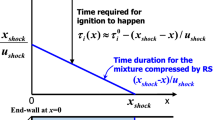Abstract.
Ignition delay times have been measured behind reflected shock waves using infrared and ultraviolet emission spectroscopies in the wide ranges of temperature (1485-1900 K), pressure (0.3-1.3 MPa), equivalence ratio (0.5-2) and dilution with argon (95-99%). For a mixture composed of several alkanes, it has been shown that the ignition delay can be evaluated from a combination of individual expressions obtained for each alkane (methane, ethane and propane). This method is applied to ignition delay time calculations for mixtures of several natural gases and validated with a particular Algerian natural gas. The measured ignition delay time are compared with those computed using a detailed kinetic mechanism. Agreement is generally satisfactory but the deviation between measurements and calculations increases when the ethane relative fraction increases in natural gas. Dynamic parameters of detonation in air are evaluated from these correlations. The predicted kinetic parameters of detonation (cell width) with a natural gas from Abu Dhabi, especially rich in ethane, are about half as those estimated with a Russian natural gas.
Similar content being viewed by others
Author information
Authors and Affiliations
Corresponding author
Additional information
Communicated by V.M. Fomin
Received: 16 April 2002, Accepted: 4 October 2002, Published online: 8 May 2003
Rights and permissions
About this article
Cite this article
Lamoureux, N., Paillard, C.E. Natural gas ignition delay times behind reflected shock waves: Application to modelling and safety. Shock Waves 13, 57–68 (2003). https://doi.org/10.1007/s00193-003-0188-z
Issue Date:
DOI: https://doi.org/10.1007/s00193-003-0188-z




